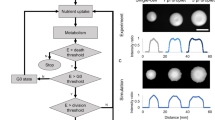Abstract
The growth rates of aspergillus, fusarium, and penicillium microorganism colonies in ‘Czapex Dox Agar’ as a feed material, under room conditions, are observed to be linear. This phenomenon is mathematically modeled and exactly predicted on the basis of the exponential growth assumption of a single microorganism. The approach allows an easy determination of the multiplication constant of a ‘had microorganisms been allowed to grow freely’ microorganism, in given conditions.
Similar content being viewed by others
References
Yarman, T. and Yarman, F. A., Project report on preventing sprouting on ETI cakes, Engineering Department, Anadolu University, 1985.
SamsonA. R., HoestraS. E., and vanDorschotA. N. C., Introduction to food-borne fungi, Centraalbureau voor Schimmelculturen, Baarn, 1981.
Author information
Authors and Affiliations
Rights and permissions
About this article
Cite this article
Yarman, T., Kiyak, N. A simple mathematical modeling of the growth of microorganism colonies. J Biol Phys 17, 265–269 (1990). https://doi.org/10.1007/BF00386601
Received:
Issue Date:
DOI: https://doi.org/10.1007/BF00386601




